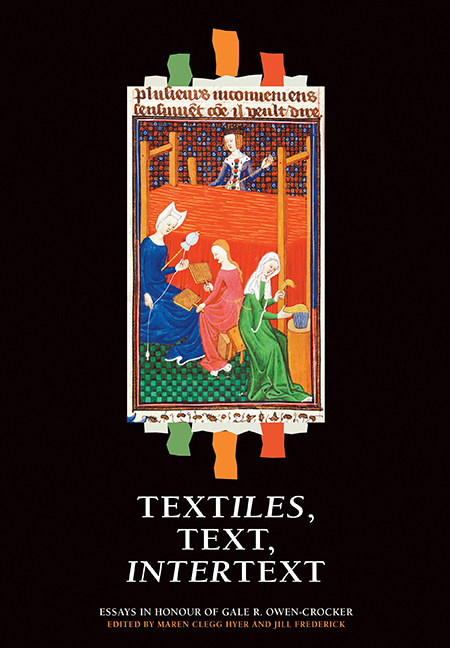Book contents
- Frontmatter
- Contents
- List of Illustrations
- List of Abbreviations
- Introduction
- A Personal Recollection
- List of publications of Gale R. Owen Crocker
- Part I Textile
- Part II Text
- Part III Intertext
- 10 Weaving Words on the Ruthwell Cross
- 11 Fates of the Apostles and Tituli
- 12 Weaving and Interweaving: The Textual Traditions of Two of Ælfric's Supplementary Homilies
- 13 Invisible Things in London, British Library, Cotton Vitellius A. xv
- 14 Redacting Harold Godwinson: The Vita Haroldi and William of Malmesbury
- Index
- Tabula Gratulatoria
14 - Redacting Harold Godwinson: The Vita Haroldi and William of Malmesbury
from Part III - Intertext
Published online by Cambridge University Press: 05 July 2016
- Frontmatter
- Contents
- List of Illustrations
- List of Abbreviations
- Introduction
- A Personal Recollection
- List of publications of Gale R. Owen Crocker
- Part I Textile
- Part II Text
- Part III Intertext
- 10 Weaving Words on the Ruthwell Cross
- 11 Fates of the Apostles and Tituli
- 12 Weaving and Interweaving: The Textual Traditions of Two of Ælfric's Supplementary Homilies
- 13 Invisible Things in London, British Library, Cotton Vitellius A. xv
- 14 Redacting Harold Godwinson: The Vita Haroldi and William of Malmesbury
- Index
- Tabula Gratulatoria
Summary
Towards the end of Vita Haroldi, the early thirteenth-century (c. 1205) life of King Harold Godwinson composed at Waltham, the author asserts the truth of his account, even though its details may differ from what others have written about Harold:
Regarding the facts of Harold's life, it is evident that both common speakers and renowned orators have not only thought and written about it differently, but also quite the contrary to each other. But by the evidence of reason as well as authority, that which opposes [truth] cannot be true.
At first glance, this is an audacious position for the Vita's author to take, given that his own text asserts that Harold in fact did not die on the battlefield at Hastings in 1066, but survived, was healed by a Saracen woman, and then travelled the world before returning to his native England to live out a long life as a holy man, first among the Welsh, and then as a hermit at Chester. Produced at Waltham, an abbey that had Harold as its patron, the Vita has been aptly described as a “secular hagiography”, and much of its narrative is patent invention, flying in the face of all received historical tradition and evidence. It is challenging, therefore, to regard this text as a historical source. In the nineteenth century, E. A. Freeman dismissed the work in frank terms, as “utterly worthless” and “mere romance, food for the comparative mythologist rather than for the historian, and valuable only as illustrating certain … tendencies of the human mind”. While the Vita has been the subject of a small number of studies in the past few decades, it is safe to say that no one considers its biographical details of Harold's life after 1066 as anything approaching a true and factual account.
As the Vita's rhetoric suggests, the historical record of King Harold Godwinson's end in 1066, already a dense skein of textile, text, and image, is further complicated by the twelfth-century rise of legends of Harold's survival. In accounts of Harold's fate, the antagonism evident between these competing traditions has much to tell us about the formative processes of medieval history, and in particular the intertextual strategies which work to ratify one tradition as authentic, and reject the other as fantasy.
- Type
- Chapter
- Information
- Textiles, Text, IntertextEssays in Honour of Gale R. Owen-Crocker, pp. 239 - 254Publisher: Boydell & BrewerPrint publication year: 2016



